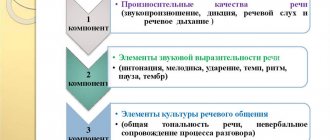Exercises for older preschool children
Rhetoric (exercises for the development of oral speech train the centers of the brain) has different levels of complexity. For children of senior preschool age, classes are held, the content of which corresponds to the amount of knowledge of each child.
Exercise “Story on a free topic”
To perform this collective exercise, it is enough for a group of children to be formed in the amount of 5 to 10 people. The average duration of a lesson is from 25 to 50 minutes. This is the period of time that will allow you to achieve maximum productivity in the educational process, as well as maintain a sufficient level of interest in children. Each child is given about 5 minutes to perform.
Goals and objectives
The main goal and objective of the exercise is to effectively form a culture of child’s speech behavior.
Equipment and materials
To conduct this lesson you will need the following equipment and materials:
- chairs to seat all group members, creating a target audience for the speaker;
- a clock with a timer to record the duration of each child’s performance;
- a chair and desk for the teacher, who sits away from the children;
- an improvised stage on which each child will appear during their performance.
After completing the preparatory activities, you can begin this exercise.
Methodology used
During this exercise, it is recommended to use a technique for assessing the progress of each child. To do this, you will need to prepare a checklist in advance, which will display the achievements of all students.
Introduction
At this stage, the teacher invites the children to take turns going on stage and performing an oral story on a given topic. The teacher focuses on the fact that the narration should be expressive, interesting, but at the same time as concise as possible, since each speaker has only 5 minutes.
Progress of the lesson
Completing the exercise “Story on a free topic” involves following the following algorithm of actions:
- The teacher invites the child onto an improvised stage in front of an audience of other children.
- Then the teacher asks the student to tell a story about a particular event. For example, a story on the topic: “How I visited my grandmother,” “Fishing trip with my father,” “My pet.” The topic for the story is chosen to be free and accessible to a child of the appropriate age.
- The child talks about a given topic for 5 minutes.
- After this, the teacher, together with the children, thanks the speaker, and then invites the next child to speak.
Children who are lost, embarrassed or have difficulty telling a story during a speech need to be encouraged and given confidence in their actions.
Knowledge control
At the end of the training, the teacher fills out a checklist in which he evaluates the speaking abilities of each child.
The following criteria are taken into account:
- clarity of speech;
- expressiveness;
- richness of vocabulary;
- content of the speech;
- brevity.
To carry out the assessment, a scale of 5 or 10 points is used. At the same time, the results of knowledge control are not disclosed to the children, but are used only by the teacher to further improve the rhetorical skills of each child.
The final stage
At the final stage of this lesson, the children thank each other for the interesting stories they heard during this exercise.
Exercise “Characteristics of an object”
Characterizing an object is an exercise that requires forming a group of 5 children. The average duration of a performance for 1 child is 10 minutes.
In total, the lesson lasts 50 minutes. working hours.
Goals and objectives
The purpose of this lesson is to form in the child the initial inclinations for oratory skills, to teach him the correct and consistent presentation of thoughts.
Equipment and materials
To conduct this lesson you will need to use the following materials:
- ball;
- Toothbrush;
- pencil;
- paper;
- plasticine.
All children of primary preschool age are familiar with these objects and can also describe their characteristics and purpose.
Methods used
During this lesson, methods are used in the form of assessing the child’s abilities using a checklist, and also use presentation techniques.
Introduction
At the preparatory stage, the teacher places the above items on the table in front of the children. After this, the teacher tells the children that they need to take turns standing up, coming forward and describing one of these things.
Progress of the lesson
An exercise to develop rhetorical abilities “Characteristics of the subject” is performed as follows:
- The teacher invites the child to an impromptu stage.
- The speaker receives one of the items described in the section above.
- According to the teacher’s instructions, the child spends 10 minutes. must tell the maximum amount of information about the thing given to him. The characteristics of the object and its intended purpose are fulfilled.
- After the specified period of time has passed, the child sits down, and the next group member is invited to perform.
During this lesson, the teacher can ask the child leading questions that simplify the storytelling process.
Knowledge control
Based on the results of the training, the teacher assigns grades to all participants in a checklist.
The final stage
At the final stage of the lesson, the teacher thanks the children for participating in the training, says that they tried very hard, and their stories were interesting.
Summary of a lesson on rhetoric in the preparatory group on the topic “Competition: Entering the Theater”
Summary of a lesson on rhetoric in the preparatory group on the topic: “Competition “Entering the Theater””
Program content:
- Develop the ability to navigate in a new non-standard situation. Think through courses of action and find new ways to solve problems.
- Teach children to dramatize passages from familiar fairy tales, getting into character.
- Improve the ability to make decisions and apply knowledge in certain life situations.
- Strengthen children's ability to quickly solve puzzles and riddles.
- Practice clear, intelligible pronunciation of sounds and syllables in tongue twisters and tongue twisters.
- Develop phonemic awareness; logical thinking.
- Exercise children in the ability to breathe correctly.
- Cultivate resourcefulness and courage.
Dictionary enrichment:
weaves, weaver, arrogant, clicked, plastic, no argument.
Activating the dictionary:
facial expressions, gestures, ringing, beets.
Materials for the lesson:
puzzles, crosswords, a bowl of water, paper boats, a costume of a wolf, Little Red Riding Hood, grandmother, director, administrator, cassettes with recordings of the music “Waltz” from the film “My Affectionate and Tender Beast”, dance “Turn” - music. N. Sushenoy, “Pair Dance” - Karelian folk melody.
Progress of the lesson:
Playback: - Attention! Attention! A competition for admission to the theater is announced. Those interested can come to the entrance. Administrator: - In order to enter the theater, you need to pass a competitive selection. Vosp.: What is this? Adm.: -This is the same exam. You need to show everything you can: speak well, sing, read poetry, and much more. V.: - Shall we try, guys? Children: - Yes! Yes! The administrator comes out and invites you to the first competition. The theater director takes the exam.
1 competition: “Can you breathe correctly?”
1. At the exit, count to 10. 2. “We’re going in the elevator” (announce the floors: 1st, 2nd, 3rd, etc.) 3. “Raise a storm” (who blows the strongest). 4. “Storm at sea” (who will drive the boat further from the shore). Director: - You have completed this competition, let's move on to the next one.
2nd competition
: Speech gymnastics. Dir.: - It is very important for an artist to be able to clearly pronounce all sounds and take the breath correctly. Children pronounce tongue twisters:
— A weaver is weaving fabric for Tanya’s scarf. - The hedgehog has a hedgehog, the snake has a snake. — There is a slide in the yard, there is a mink under the slide. - Senya Dunno, and Zina Zaznaika. — Klava put the onion on the shelf and called Nikolka to her. — On the window, the cat deftly catches a tiny midge with its paw.
Director: - Okay, guys! You also completed this task. And now the next competition.
3rd competition
: Game “Which sound is heard more often” (development of phonemic hearing).
- Goose Gyga and Goose Gaga Not a step without each other. - Walruses are not afraid of frost, Walruses frolic in the cold. - The rooster sings about colorful birds, about lush feathers and fluff. — The cat saved a few pennies. He bought the cat a goat.
Director: — You did an excellent job in this competition. Let's move on to the following:
4th competition:
Dance and plastic competition. Children show dance elements to music: polkas, waltzes...
Director: - Well done! This was one of the easy competitions, but now let's see how you can dramatize.
5th competition
: For example: an excerpt from the fairy tale “Little Red Riding Hood”. An episode of a meeting between a wolf and a girl in the forest, and then at her grandmother’s hut. Pay special attention to children’s facial expressions, gestures, and getting into character.
Director: - Well, you successfully passed this competition too. Well done!
6th competition:
- Attention: chants!
- - Caught a bear!
-Bring it here! - It doesn’t work! - So go yourself! - He won’t let me in! 2. – Martin! Have you eaten the pie? - No, not me! - Do you want more? -Want!
3. – Laziness, oh laziness! Open the door, you'll burn! - Let me burn, but I won’t open it!
Dir.: - We finished shouting! Well done!
7th competition:
How to say it correctly? Rings, rings, Beetroot, beetroot, Put it down, put it down, etc.
Director: - To be honest, I did not expect such brilliant results. Well done! And now the reading competition. Who can read a poem with expression, stopping in time, changing the strength of the voice, making logical pauses. Who is braver?
Director: - I enjoyed listening to your poems. I want to see how smart you are. Next competition: solving puzzles.
Children solve puzzles: (puzzles are prepared in advance)
Dir.: - Ninth Competition
"Explain the proverb"
- A hut cannot be destroyed by shouting.
- Labor feeds, but laziness spoils.
- Noise doesn't help matters.
Director: - Well done, guys! And now the last competition, a humorous one:
- What can you see with your eyes closed? (dream)
- A stone fell into the water, what did it become? (wet)
- What question will no one ever answer “yes” to? (are you sleeping?)
- What should you do if you see a tiger in a dream? (wake up)
Director and administrator: - Congratulations guys! — You have been accepted into our theater. We will be happy to wait for you. See you soon!





